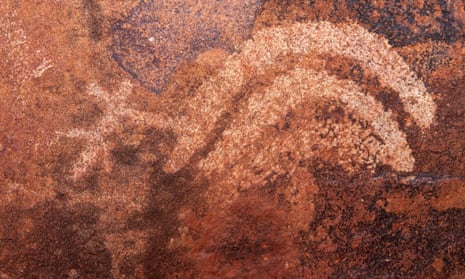Traditional custodians fighting to protect ancient rock art on the Burrup peninsula have raised concerns that construction work has begun at multiple sites despite the federal government ordering a cultural heritage assessment of the area.
The peninsula in northern Western Australia is home to industrial operations including of the country’s largest gas producer Woodside, the Yara Pilbara ammonia plant and a proposed urea plant by Indian company Perdaman.
Last month the environment minister, Tanya Plibersek, refused an application to prevent work going ahead on new construction at the Perdaman fertiliser plant under section 9 of federal Aboriginal heritage laws. However, she allowed a different application, known as a “section 10” to go ahead.
This involves appointing a reporter to investigate claims rock art in the area – which is a nominated world heritage site – may be damaged by industrial activity, before making recommendations to government about how to respond.
The Burrup has been described as a testing ground for Australia’s evolving stance on protecting Indigenous cultural heritage.
Raelene Cooper, a Mardudhunera woman and former chair of the Murujuga Aboriginal Corporation, said the imminent start of construction of a green hydrogen production facility was placing increasing pressure on the area.
“We just secured a full cultural heritage assessment of all industry on the Burrup at the same time that Perdaman, Yara and Woodside are all ramping up their plans and starting construction on projects that threaten sacred Murujuga rock art,” Cooper said.
Ammonia producer Yara fertiliser said last week the company would begin work on the construction of the Yuri green hydrogen plant in partnership with French renewables giant Engie in October.
The construction follows the start of work on Woodside’s Pluto Train 2 gas processing facility, which is one of a number of industrial projects in the region including the $16.5bn Scarborough gasfield and the long-promised Browse project.
A spokesperson for the company said a ground breaking ceremony was held in August. Barbara Sinclair from the Wirrawandi Aboriginal Corporation performed a Welcome to Country and the Murujuga Aboriginal Corporation CEO, Peter Jeffries, spoke on the day.
Woodside has said it respected the diversity of views in the community and was pleased with the support it had from traditional custodians.
after newsletter promotion
Perdaman’s proposed $4.5bn urea plant has yet to begin construction, with a company spokesperson saying it was “working on the financing for the project”. Perdaman has said it has followed all legal and statutory approval processes for the last four years.
Cooper also said the companies have not properly explained why they are building on the Burrup peninsula itself rather than on the Maitland Industrial Estate, which has been zoned for industrial use and poses no threat to rock art.
“Green energy is obviously a good thing, but why does [the Yara] plant have to go on the Burrup?” she said.
“Yara’s hydrogen plant will only power a tiny fraction of the fertiliser plant but the solar panels will overshadow the world heritage values of the Burrup as we wait for Unesco.”
In response to a Question on Notice published on Tuesday the Environmental Protection Authority said Perdaman had told it constructing its plant on the industrial estate would cost $700m to $1bn and involve the construction of a “conveyer” that would require the clearing of Murujuga land.
